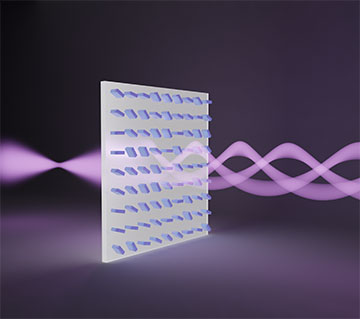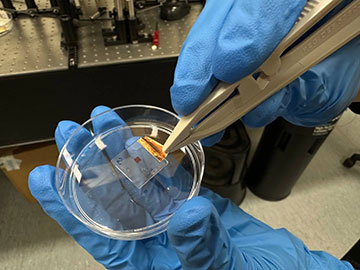
Artist’s conception of a metasurface creating a triple-helix solenoid beam. [Image: University of Melbourne]
Manipulating tiny particles with light beams sometimes requires pulling as well as pushing. Most attempts at making such an optical “tractor beam,” however, have their limitations, either with the complexity of the devices needed to shape the light or the type of particles that respond to the pull.
Now, a research team in Australia says it has devised a simple way to make a tractor beam: pass it through a tiny silicon metasurface (ACS Photonics, doi: 10.1021/acsphotonics.4c00874). The resulting triple-helix solenoid beam exhibits negligible diffraction with higher transmission than previous experiments with similar goals.
Inside a tractor beam
Simple radiation pressure from a light beam pushes particles in the direction the light is traveling, but pulling objects toward the light source requires ingenuity―and some serious beam shaping. Previous efforts over the last decade or so have honed in on helical and solenoid beams as creators of pulling forces. A solenoid beam consists of two or more Bessel beams superimposed to make a spiraling field that draws particles upstream.
However, limitations have cropped up. “For example, one method required the laser beams to be modulated in time,” says Optica Fellow Kenneth Crozier, University of Melbourne, who is chief investigator of the study. “Another method required the particle to be at the interface between materials with different refractive indices.” Some experiments used spatial light modulators to create solenoid beams, but the components are too bulky for handheld or chip-based systems.

A University of Melbourne researcher prepares a dielectric metasurface for an optical beam experiment. [Image: University of Melbourne]
Instead, Crozier and colleagues designed a geometric-phase metasurface, built from amorphous silicon pillars, that is only about 0.5 μm thick. The team sent light from a 1064-nm-wavelength Nd:YAG laser through a single-mode fiber, a collimator, a linear polarizer and a quarter waveplate to create a circularly polarized beam. The researchers found that once those rays pass through the metasurface, they spin into a helical shape.
According to Crozier, the group’s biggest challenge was determining the orbital angular momentum values of the beam’s two components via interferometry.
Future plans
The Melbourne team has not yet studied the range of particle sizes and masses that the metasurface-based tractor beam could pull. “Optical tweezers usually face difficulties in trapping particles greater than 10 μm in diameter, so perhaps that would also be the case for the tractor beams,” Crozier says.
Next, the researchers will test the metasurface-generated tractor beam’s ability to pull microparticles. Crozier suggests one potential use for the beam: pulling particles onto a sensor in a microfluidic chip to speed up sample assays. The tractor beam could also scoop up cells to make tissue biopsies less painful.
